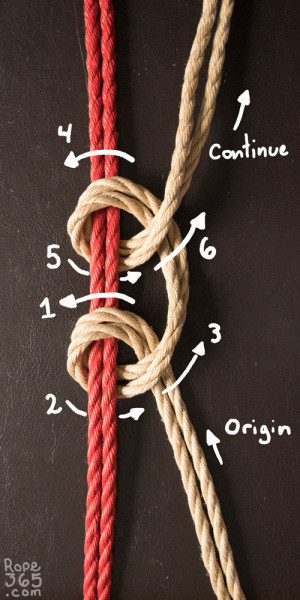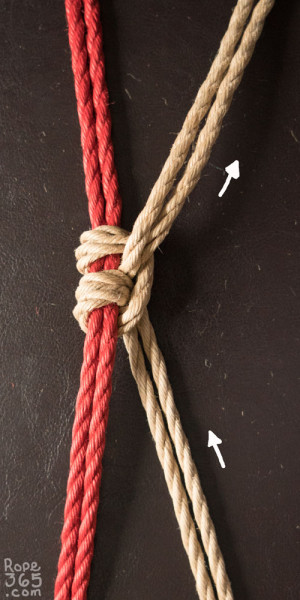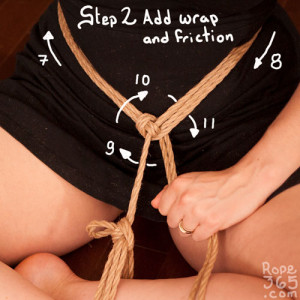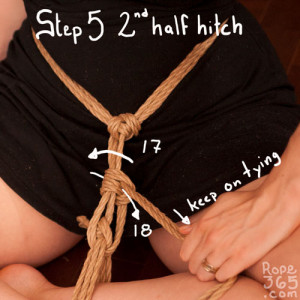Day 4: Locking and Finishing
At some point, it’s time to let go of the rope and this is when more specialized knots will come in handy to tie everything in place. You may want to use a lock when finishing the tie, or just to secure a part of the tie before moving to something else.
Clove Hitch
Sailors have a long history of using many different knots, the clove hitch is one of the most common methods to lock lines on a boat. It is a very fast way to tie a rope in place, efficient, not the most secure, but easy to remember.
Crossed-Leg Pose
Binding the ankles to the waist in a sitting position is a great way to practice locking the rope in place. Tying the lower body in a cross-legged position is called agura shibari 胡座縛り in Japanese.
Here we use a variant of the clove hitch called two half-hitches. It is the same knot form as the clove hitch, but tied on its own rope after a change of direction, making it a bit more secure. Since a clove hitch can slide, tying it right after a change of direction will limit its movement.
Finishing Ties
Once our lock is in place, what to do with the rest of the rope? There are many options, depending on the amount of rope left and the intentions of the tie. The leftover rope can be used to decorate, strengthen the structure, add more restriction, or caress your partner.
If you have a long rope left, why not continue the tie? Add another limb, wrap around the body a few times. You can also use the rest of the rope as a leash, play and pull on it to create sensations.
Once you have a short amount of rope left, you might want to hide the remaining rope for functional or aesthetic reasons. Wrapping over the existing structure will allow you to waste the rest of the rope, then you can tuck the ends between two ropes. This works best if the ropes are under tension, and knots at the of the rope will help to keep it in place.
We will continue our exploration of finishing ties in Day 210.
Video Tutorial
Activate subtitles or transcript to view instructions. Please like and subscribe to support the channel. Also available on Vimeo thanks to our patrons on Patreon.
Practice Time!
Tie a lock and test it to see how secure it is using the crossed-leg tie pose, or any other tie that binds two limbs together.
Self-evaluation checklist:
- There are no unnecessary twists in the rope
- The rope folds in a way that makes the lock compacted for maximum efficiency
- Can the lock slide or move? Is that a problem?
Exploration ideas
- Play with different locations of lock. What feels the most secure?
- How fast can you tie it?
- How fast can you untie it?
- The lock can become difficult to untie when under a lot of pressure, pull strongly on the tail and move around in the tie before untying to see the difference.
- How is the regular clove hitch different from the two half-hitches variant?
- How much space do you need between the change of direction and the first half hitch of the two half-hitches knot? Enough so it remains easy to tie. Not too much to prevent sliding.
- How do you use the rest of the rope after a lock? Does it stay in place if the person in the tie wiggle around?
- Do you know other knots that can be used to lock the tie in place?
Being Tied: Crossing Your Legs (Nobody Else’s) – sansblague
In this exercise, you are invited to sit cross-legged. If you are incapable of sitting cross-legged directly on the floor, you can try sitting on a pillow to get your sit bones up a bit, or even sit on a stool or chair. The pattern still works the same way. If you are capable of sitting cross-legged directly on the floor, explore where you are most comfortable placing the legs. If you are going to stay in this position for a while, you want to make sure it is a good one for you.
Inspirations and Resources
Credit: Clove hitch pictures – R/P: Ebi McKnotty Cross-leg pose pictures – M/R:Ebi McKnotty P: AlexK7









Leave a Reply